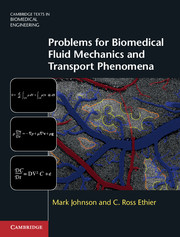Book contents
- Frontmatter
- Dedication
- Contents
- Preface
- 1 Problem solving
- 2 Conservation of mass and theReynolds transport theorem
- 3 Steady and unsteadyBernoulli equation and momentum conservation
- 4 Viscous flow
- 5 Momentum boundary layers
- 6 Piping systems, frictionfactors, and drag coefficients
- 7 Problems involving surface tension
- 8 Non-Newtonian blood flow
- 9 Dimensional analysis
- 10 Statistical mechanics
- 11 Steady diffusion and conduction
- 12 Unsteady diffusion and conduction
- 13 Convection of mass and heat
- 14 Concentration and thermal boundarylayers
- 15 Mass and heat transfer coefficients
- 16 Osmotic pressure
- Appendix A Material properties of fluids
- Appendix B Transport equations
- Appendix C Charts
- References
- Permissions
6 - Piping systems, friction factors, and drag coefficients
(6 problems)
Published online by Cambridge University Press: 18 December 2013
- Frontmatter
- Dedication
- Contents
- Preface
- 1 Problem solving
- 2 Conservation of mass and theReynolds transport theorem
- 3 Steady and unsteadyBernoulli equation and momentum conservation
- 4 Viscous flow
- 5 Momentum boundary layers
- 6 Piping systems, frictionfactors, and drag coefficients
- 7 Problems involving surface tension
- 8 Non-Newtonian blood flow
- 9 Dimensional analysis
- 10 Statistical mechanics
- 11 Steady diffusion and conduction
- 12 Unsteady diffusion and conduction
- 13 Convection of mass and heat
- 14 Concentration and thermal boundarylayers
- 15 Mass and heat transfer coefficients
- 16 Osmotic pressure
- Appendix A Material properties of fluids
- Appendix B Transport equations
- Appendix C Charts
- References
- Permissions
Summary
Consider the case of mitral regurgitation. If the connection between the ventricle and atrium can be treated as a hole of diameter 0.2 cm, estimate the rate of leakage from the ventricle into the atrium at a time when the ventricular pressure is 100 mm Hg and the atrial pressure is 10 mm Hg. (Note that 760 mm Hg = 1.01 × 105 Pa.) You can neglect unsteadiness. Use a blood density of 1.06 g/cm3 and a viscosity of 0.04 g/cm per s.
One way to measure cardiac output is to inject a tracer into the blood stream and watch how quickly it disperses. This requires a rapid injection of tracer, which is often done by using a tracer-injector device.
One such injector consists of a large syringe that creates a pressure of 300 kPa. The tracer flows from the injector through 4 m of smooth plastic tubing of internal diameter 3 mm, then through a smooth 23-gauge needle (4 cm long, internal diameter 0.455 mm) before entering a peripheral vein where the pressure is 10 mm Hg (1.333 kPa). Neglecting minor losses and the height difference between the injector and the vein, what will the flow rate of tracer be?
- Type
- Chapter
- Information
- Publisher: Cambridge University PressPrint publication year: 2013



